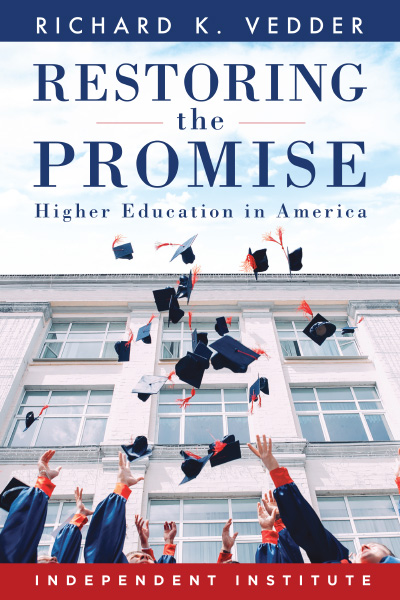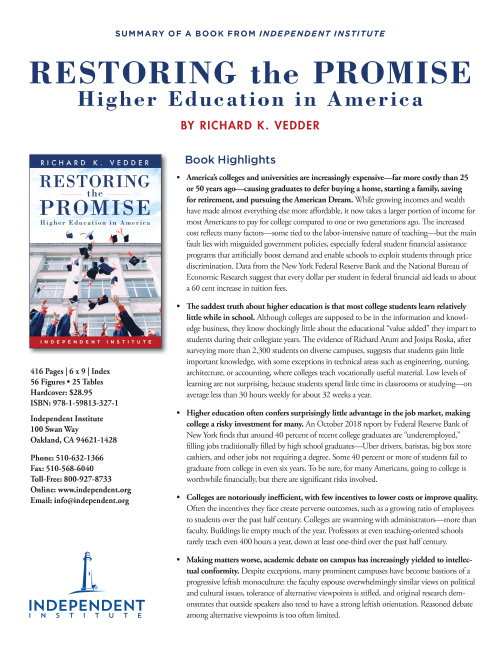Highlights
- America’s colleges and universities are increasingly expensive—far more costly than 25 or 50 years ago—causing graduates to defer buying a home, starting a family, saving for retirement, and pursuing the American Dream. While growing incomes and wealth have made almost everything else more affordable, it now takes a larger portion of income for most Americans to pay for college compared to one or two generations ago. The increased cost reflects many factors—some tied to the labor-intensive nature of teaching—but the main fault lies with misguided government policies, especially federal student financial assistance programs that artificially boost demand and enable schools to exploit students through price discrimination. Data from the New York Federal Reserve Bank and the National Bureau of Economic Research suggest that every dollar per student in federal financial aid leads to about a 60 cent increase in tuition fees.
- The saddest truth about higher education is that most college students learn relatively little while in school. Although colleges are supposed to be in the information and knowledge business, they know shockingly little about the educational “value added” they impart to students during their collegiate years. The evidence of Richard Arum and Josipa Roska, after surveying more than 2,300 students on diverse campuses, suggests that students gain little important knowledge, with some exceptions in technical areas such as engineering, nursing, architecture, or accounting, where colleges teach vocationally useful material. Low levels of learning are not surprising, because students spend little time in classrooms or studying—on average less than 30 hours weekly for about 32 weeks a year.
- Higher education often confers surprisingly little advantage in the job market, making college a risky investment for many. An October 2018 report by Federal Reserve Bank of New York finds that around 40 percent of recent college graduates are “underemployed,” filling jobs traditionally filled by high school graduates—Uber drivers, baristas, big box store cashiers, and other jobs not requiring a degree. Some 40 percent or more of students fail to graduate from college in even six years. To be sure, for many Americans, going to college is worthwhile financially, but there are significant risks involved.
- Colleges are notoriously inefficient, with few incentives to lower costs or improve quality. Often the incentives they face create perverse outcomes, such as a growing ratio of employees to students over the past half century. Colleges are swarming with administrators—more than faculty. Buildings lie empty much of the year. Professors at even teaching-oriented schools rarely teach even 400 hours a year, down at least one-third over the past half century.
- Making matters worse, academic debate on campus has increasingly yielded to intellectual conformity. Despite exceptions, many prominent campuses have become bastions of a progressive leftish monoculture: the faculty espouse overwhelmingly similar views on political and cultural issues, tolerance of alternative viewpoints is stifled, and original research demonstrates that outside speakers also tend to have a strong leftish orientation. Reasoned debate among alternative viewpoints is too often limited.
Synopsis
American universities are facing unprecedented challenges: falling enrollments and declining public support are causing more schools to close their doors. In a half of a century, they have gone from a Golden Age of expansion and affluence to a drearier era of decline. What’s troubling academia—and what can be done to spark renewal?
The answers are complex. But at the heart of the problem, according to economist Richard K. Vedder, is that higher education lacks incentives to change, to innovate, to operate efficiently. It often even lacks vital information measuring the problems it faces. Much of the difficulty arises because third parties, especially government, help finance the enterprise, so the discipline that markets impose on businesses does not exert its salutatory effects in the academy.
In Restoring the Promise: Higher Education in America, Vedder offers a probing analysis of serious problems facing higher education, particularly its excessive costs, inadequate student academic achievement, and its failure to prepare graduates for life beyond the academy. More than a diagnosis of what ails American academia and why, Restoring the Promise offers powerful prescriptions to cure the underlying problems and foster a renaissance in higher education.
Higher Education’s Triple Crisis
Many Americans—some polls say a majority—complain that colleges are too costly. College prices have risen roughly three percent more annually than the overall inflation rate in the past 40 years, although that increase is now slowing.
Rising costs might be warranted if this were accompanied by qualitative improvements in educational services. But are students actually learning more? The evidence suggests otherwise. The most comprehensive study, by Richard Arum and Josipa Roksa, shows little improvement in critical thinking or writing abilities during college. In addition, professors are teaching much less than their counterparts of the 1960s, while the students are studying a lot less—but getting much higher grades. Students are doing less for more.
Rising costs might also make sense if they conferred growing advantages in the job market, but this appears not to be the case. While college graduates earn more than high school diploma holders, that differential is not growing, and there are far more college graduate workers than jobs requiring a bachelor’s degree. Moreover, at some non-elite schools, starting pay on average is low, and many fail to graduate.
High costs, mediocre academic outcomes, and inadequate payoffs to students and society constitute higher education’s triple crisis.
How Did We Get Here?
For much of U.S. history, higher education has been a growth industry. At the time of the American Revolution, there were 774 students at nine American colleges. The numbers grew rapidly and fairly consistently until recent years, when enrollments actually started declining. Today the proportion of adult Americans with college degrees now exceeds 30 percent.
Rising incomes, population, and job-skill requirements contributed to rising demand for a college education, as did a greater college–high school earnings differential. Another factor is particularly important: the surge in federal student loan and grant programs after 1965. Some blame the labor-intensity of teaching for rising costs; others blame declining state support. Of major importance, however, is the Bennett Hypothesis: greater federal student loan availability largely explains higher tuition fees. The huge rise in federal student debt created a myriad of unintended problems, including reduced fertility and homeownership for debt-laden young adults.
Misplaced priorities only compound the problem. Although some schools depend heavily on endowments, the evidence shows that little endowment money is spent to make college more affordable to students. Instead, the staff benefit from higher compensation, lower teaching loads, and other perks. Indeed, despite rising federal financial assistance and growing endowments, the proportion of recent college graduates from the bottom quintile of the income distribution has actually declined since 1970.
Where Does All the Money Go?
At most modern universities, somewhere between 25 and 40 percent of spending goes towards things not directly related to the academic mission; it is spent on things like food services, medical clinics, or intercollegiate athletics.
But even within spending on core activities, less than half goes directly for instruction. Spending for “research,” “academic support,” “student services” and “institutional support” each consume typically over 10 percent of university budgets. Instructional and research spending as a share of budgets has fallen over time. Administrative staffs have soared in size and importance, while the faculty has lost some clout (although they have been bribed, figuratively speaking, with lower teaching loads). In the 1970s, schools typically had more than two faculty members per bureaucrat; now there is less than one.
The rise in tuition fees is accompanied by soaring prices of university-provided food and housing, which have risen faster than in the non-university private economy. University costs have increased also because of an “edifice complex,” huge outlays for elaborate buildings and sports facilities with climbing walls, atriums, and “lazy rivers.” At the same time, maintenance spending is woefully inadequate on most campuses.
The biggest collegiate scandal of all, some believe, is intercollegiate athletics. It is increasingly highly costly, with good athletic performance lining the pockets of plutocratic coaches at the expense of athletes who are underpaid but often scarred with debilitating long-term health issues. Scandals abound.
Is Educating Students a Top Priority?
As universities deemphasize teaching, they have put much emphasis on research. At many schools, research dollars are a big source of revenue. Yet much non-STEM research is not even read much or cited by other scholars. Federal policies on overhead costs for research make little sense and mainly benefit university bureaucracies. Non-university research organizations, especially think tanks, provide some needed competition.
Academic accreditation is highly ineffective—complex, costly, secretive, provides little consumer information, emphasizes inputs rather than outcomes, stands as a barrier to entry and innovation, and promotes excessive federal control. It also is riddled with conflicts of interests.
Another challenge to traditional aims of higher education can be heard in the top buzzword on today’s campuses: “diversity.” By most measures, universities are far more demographically diverse than ever. Yet despite growing enrollment of racial minorities, their academic performance is often disappointing, in part because of mismatching—pushing minorities to attend schools for which they are academically unprepared.
Another sort of diversity, however, has declined: diversity of the mind. Campuses are increasingly dominated by left-oriented faculty, sometimes to the exclusion of many alternative perspectives. More fundamental is the problem of governance: who runs—or even “owns”—the universities? Governing boards are often rubber stamps for administrations, often ignorant of key facts needed to make objective decisions.
Where Do We Go from Here?
To spark a renaissance in higher education, three “I” words are critical: information, incentives, and innovation. We need better information about how much students learn; we need for schools to have a greater stake in boosting academic achievement; and we need smarter ways to improve educational services.
In a major way, higher education is a poster child for government failure. Government—at both the state and federal level—has contributed importantly to the huge increase in the costs of attending universities, providing instead “economic rents” (unnecessary income/compensation payments) to faculty and staff. The U.S. Department of Education has not helped.
What to do? The most fundamental reforms involve ending university monopolies on certifying educational and vocational competence. One alternative is to develop competitive institutions of quality control. For example, non-college organizations could package academic courses and award degrees whose quality is verified by external examination.
Another key reform is to eliminate, or at least radically reform, traditional federal student financial aid programs. One alternative is to promote new private ways of funding, such as Income Share Agreements. Another measure sure to ameliorate the problem is to insist that colleges share in covering loan defaults (i.e., “have skin in the game”). Many smaller reforms would also be useful, such as downsizing university bureaucracies, offering three-year bachelor’s degrees, ending grade inflation, and prohibiting race-centered admissions.
If changes are not made either from within or from outside pressure, markets will force some much needed Schumpeterian “creative destruction” upon American higher education. The sooner we address the problems head on—by focusing on obtaining actionable information, properly aligning the institutional incentives, and fostering educational innovation—the sooner we will enjoy the fruits of an educational renaissance.








